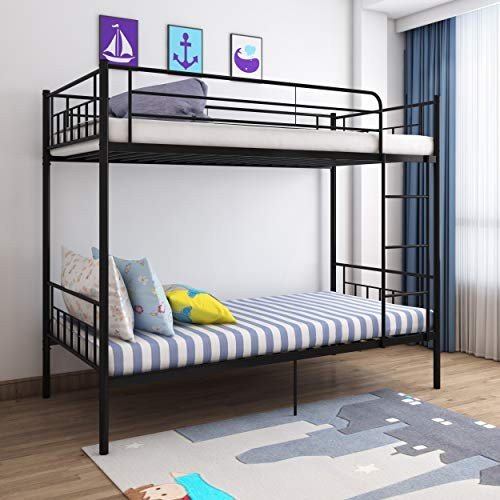20 Trailblazers Lead The Way In Bunk Beds
Exploring Bunk Beds: A Comprehensive Guide
Bunk beds have long been a staple in children's bed rooms, dorms, and even homes with limited space. Not only do they provide a useful sleeping solution, but they likewise create an enjoyable and imaginative environment for children and a great space-saver for adults and families. Kids Bunk Beds helaineherke.top will check out everything you need to understand about bunk beds, from types and materials to safety tips and purchasing advice.
Table of Contents
- Kinds Of Bunk Beds
- Traditional Bunk Beds
- Loft Beds
- Triple Bunk Beds
- L-Shaped Bunk Beds
- Material Options
- Wood
- Metal
- Safety Considerations
- Purchasing Guide
- Frequently asked questions
Types of Bunk Beds
Bunk beds are available in numerous styles to match different requirements and preferences. Here's a breakdown of the most typical types:
Conventional Bunk Beds
Conventional bunks normally feature 2 beds stacked vertically on top of one another. These beds are ideal for siblings sharing a space or for optimizing sleeping space in visitor spaces.
Loft Beds
Loft beds stand likewise to traditional bunk beds but do not have a lower sleeping location. Instead, they frequently incorporate a desk or seating location below, making them a great option for little rooms requiring multifunctionality.
Triple Bunk Beds
Triple bunk beds are created for 3 residents, with beds stacked in a three-tier setup. These are less typical however can be a fun service for large households or pajama parties.
L-Shaped Bunk Beds
With one bed positioned horizontally and the other vertically, L-shaped bunk beds are often equipped with extra features such as desks or storage drawers and can complement corner spaces in a space.
Comparison of Bunk Bed Types
Bed Type
Suitable Use
Description
Traditional
Shared bed rooms or guest rooms
2 beds stacked vertically
Loft
Little spaces requiring multi-purpose space
Upper bed with open space beneath
Triple
Big families or sleepovers
3 beds stacked vertically
L-Shaped
Corner or versatile areas
A mix of vertical and horizontal beds
Product Options
Bunk beds are produced from various products, with wood and metal being the most typical. Each product has its pros and cons.
Wood
- Sturdiness: Generally robust and can withstand years of usage.
- Visual Appeal: Offers a classic appearance that can mix with different decorations.
- Weight Capacity: Typically sturdier; can support much heavier weights.
- Disadvantages: May be more expensive than metal choices and can be susceptible to scratches.
Metal
- Durability: Generally light-weight and easy to move however still tough.
- Modern Design: Often is available in sleek styles, making it appealing for modern spaces.
- Cost-Effective: Usually less pricey than wood alternatives.
- Downsides: Can be cold to the touch in winters and might not have the same visual appeal for some purchasers.
Security Considerations
When it pertains to bunk beds, security can not be ignored. Here are essential security suggestions to bear in mind:
- Guardrails: Ensure that the leading bunk has guardrails on both sides to avoid falls.
- Durable Construction: Check for a solid build and tough products to stand up to weight and motion.
- Weight Limit: Adhere to the maker's weight limitation for both the upper and lower bunks.
- Ladder Design: Choose bunks with a safe, easy-to-climb ladder and prevent any sharp edges or rungs.
- Age Restrictions: Most makers recommend that children under the age of 6 must not oversleep the upper bunk.
Purchasing Guide
When searching for bunk beds, consider the following aspects to find the best fit for your needs:
- Space Availability: Measure the room size and ceiling height, ensuring there is adequate space for the top bunk.
- Bed Size: Decide between twin, full, or bigger sizes based upon your requirements and the size of the space.
- Style Preference: Consider the total design of the bed room to find a suitable style.
- Reduce of Setup: Look for a bunk bed that is simple to put together.
- Spending plan: Bunk beds can be found in various rate varieties, so figure out a spending plan before starting your search.
FAQs
1. What is the recommended age for kids to sleep on the top bunk?
Kids aged six and older are usually suggested to sleep on the leading bunk to decrease the risk of falls.
2. How can I make my bunk bed much safer?
To boost security, guarantee guardrails are properly set up and examine that the bed is put on a flat surface. Additionally, encourage children to use the ladder thoroughly.
3. Can I transform a bunk bed into 2 different beds?
Many bunk beds are created to be convertible. Check the manufacturer's requirements for convertibility features.
4. What devices are available for bunk beds?
Common accessories consist of bed linens, storage drawers, staircases instead of ladders, and tented canopies for a fun visual appeal.
5. How do I maintain my bunk bed?
Routine look for loose screws or structural stability can help make sure security. Dust the bed frequently and tidy spills immediately to keep the materials in good condition.
Bunk beds are flexible and a space-efficient service for various living circumstances, from kids's spaces to guest accommodations. With many designs and products available, potential purchasers have a wealth of options to consider, making sure a combination of usefulness and aesthetic appeals. By prioritizing security and following the tips detailed in this guide, individuals can find the ideal bunk bed that fits their space and lifestyle, all while creating a satisfying sleeping environment.
